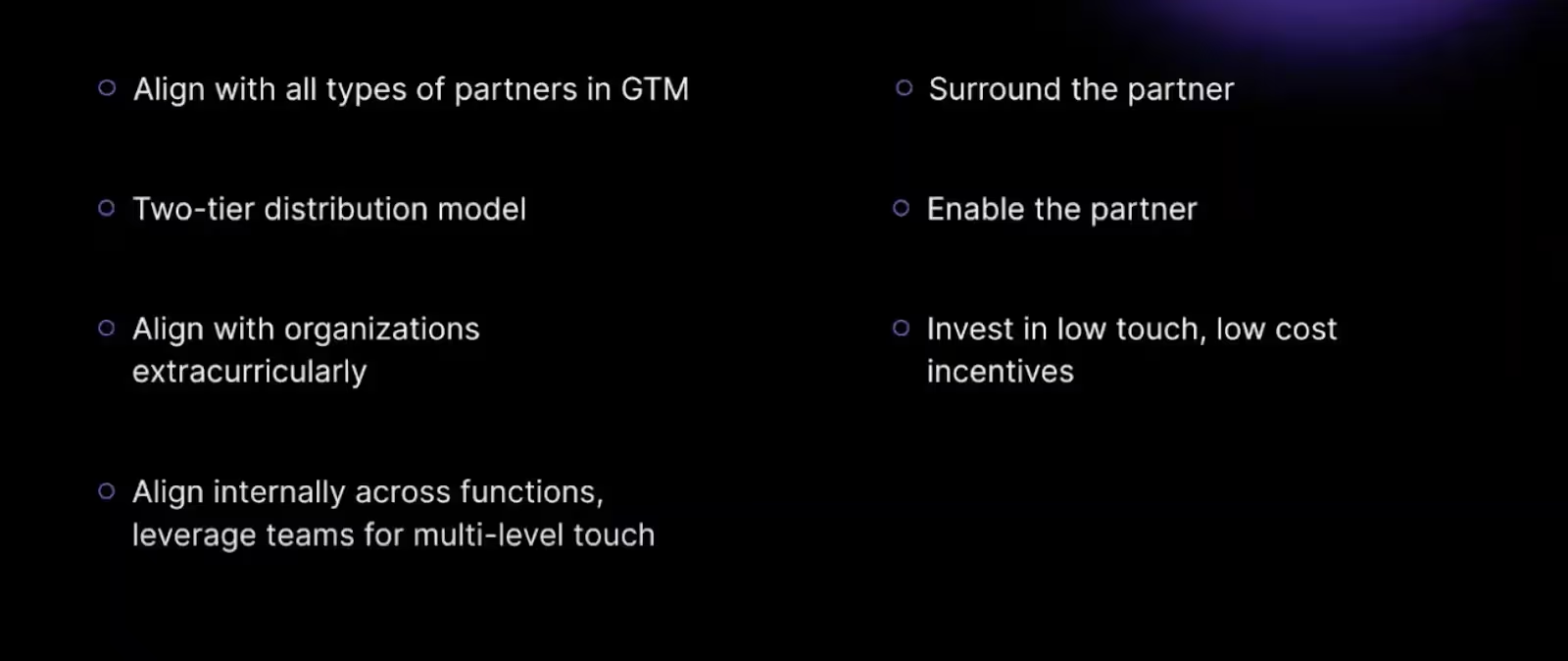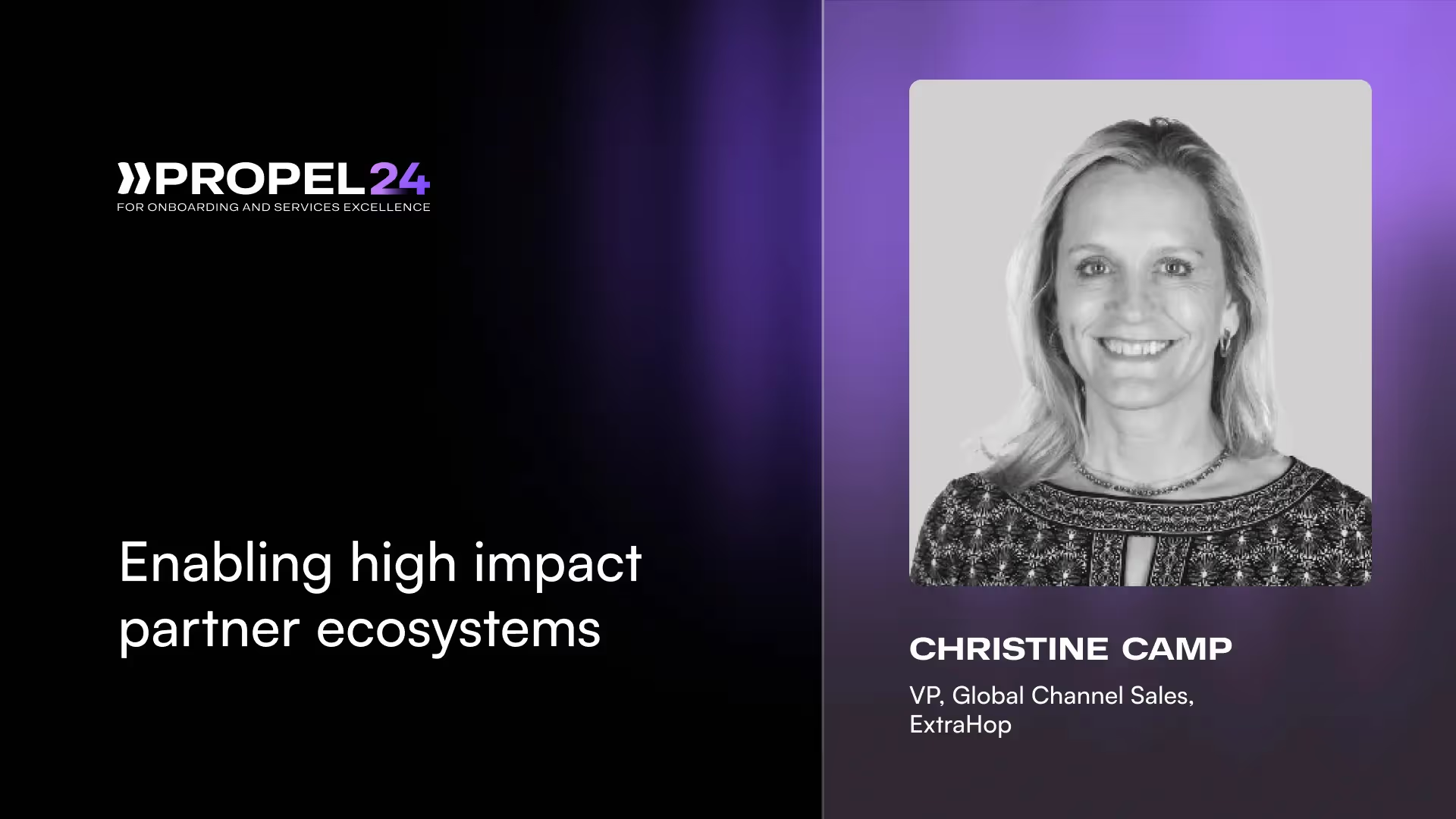Building and sustaining high-impact partner ecosystems is crucial for any organization's growth and success.
A well-structured and strategically managed partner ecosystem amplifies market reach, accelerates innovation, and drives substantial revenue growth. Businesses can then deliver superior value to customers, expand their offerings, and leverage complementary strengths.
Effective partner ecosystems are built on a foundation of mutual trust, clear communication, and shared goals. They require meticulous planning, continuous enablement, and a commitment to creating win-win scenarios for all stakeholders involved. This approach not only enhances the competitive edge but also ensures long-term sustainability and success in a rapidly evolving market landscape.
At Propel24, Christine Camp, VP Worldwide Channel Sales, ExtraHop, discusses the critical elements that make partner programs successful and offers actionable insights to foster collaboration, innovation, and growth. Her extensive background in various facets of channel management, from front-end sales to channel marketing and operations, provides her with a comprehensive perspective on the inner workings of global channel organizations. Drawing from her vast experience as both a reseller and vendor, she shares valuable lessons and strategies to help enhance partner ecosystems.
What is partner-led growth?

When considering partner-led growth, it's essential to evaluate the types of partners that align with your go-to-market strategy. This depends on your business specifics. Whether you're just starting or already have an established partner channel, it's important to progress through phases—crawl, walk, run—expanding your engagement with different partner types. These can include services-only partners, global systems integrators, global service providers, resellers, and managed service providers (MSPs). Here are a few strategies to foster a high-impact partner ecosystem that drives growth, innovation, and collaboration:
- Align with all types of partners in GTM
Working with a variety of partners requires you to align with them to set up effective go-to-market models.
- Two-tier distribution model
Most businesses consider a two-tier distribution model, where a distribution arm supports value-added resellers, favorable. It leverages the distributor's resources, which often exceed those of the vendor, enabling broader market reach and cost-effective sales management.
- Align with organizations beyond your partner network too
Aligning with orgs and networks beyond the partner ecosystem is crucial. This includes leveraging industry peers and external bodies for broader knowledge and support, such as the Partnership Leaders organization.
- Align internally across functions
Internally, cross-functional alignment is vital. Engaging with various departments—sales ops, finance, legal—ensures comprehensive support for your partner channel strategy. This is what is called the "surround the partner" model, similar to the customer journey approach in customer success. Which brings us to the next point.
- Surround the partner
Adopt a "surround the partner" strategy - understand the partner journey and ensure they have all the support needed from different touchpoints within your organization. This involves supporting and enabling partners with all necessary resources and touchpoints to ensure their success.
- Enable the partner
Once partners are onboard, enabling them is critical. Continuous training in sales, technical, pre-sales, and post-sales ensures partners are well-equipped to represent your value proposition and serve your customers effectively.
- Invest in low-touch, low-cost incentives
To keep partners motivated amidst market noise and competition, investing in low-touch, low-cost partner incentives can be effective. These rewards help maintain engagement and drive partner commitment.
Building the organization and structure for enabling high-impact partner ecosystems
Creating an effective organization structure for enabling high-impact partner ecosystems depends on your current stage of channel development and the size of your company. Whether you're starting from scratch or enhancing an existing setup, it's crucial to plan your hiring and organizational structure to support your partner channel strategy.
- Channel sales as the foundation
Setting up a partner channel for sales should be your primary focus, as revenue generation is paramount. Ensure you have enough people to support the opportunity lifecycle, from lead generation to deal closure.
- Operations and marketing support
Next, prioritize building your operations team to set up business processes, systems, and infrastructure that support your sellers. Make sure to also coordinate with your internal marketing team and have a dedicated communication plan to enhance your channel efforts.
- Technical and engineering support
Incorporate channel engineering support to leverage partners' technical capabilities and address various use cases. This feedback loop helps refine your product offerings and align with market demands.
- Cross-functional alignment
Internally, align across functions—sales ops, finance, legal, and more—to ensure comprehensive support and collaboration for your partner channel strategy. This helps create a cohesive and efficient partner ecosystem.
- Enablement and training
Equip your partners with continuous training, enablement, and the knowledge and tools they need to effectively sell and support your products. This includes sales, technical, pre-sales, and post-sales training.
- Low-cost incentives
To maintain partner engagement amidst market competition, invest in low-touch, low-cost incentives. These rewards help keep partners motivated and committed.
- Alliances and integrations
Form alliances with tech integrators and other companies that can enhance your solution's breadth and differentiation. These partners may not resell your product but play a vital role in making your solution more comprehensive and appealing.
- Verticals and public sector
If your customers operate in specific verticals like government, retail, healthcare, or finance, tailor your partner channel strategy to address their unique compliance and regulatory requirements.
Thoughtfully build out your organization and align it with your partner channel strategy. Create a robust and scalable partner ecosystem that drives growth and innovation.
What resources are required to establish a high-impact partner ecosystem?
Establishing a high-functioning partner ecosystem isn't just about having the right people in place. It's more about having the right resources, tools, and infrastructure ready for your partner channel.
Here are the key components to consider:
1. Partner Relationship Management (PRM) platform
- A PRM platform is essential for managing a sophisticated partner channel. While platforms like Salesforce or HubSpot would provide a foundation, they need to be supplemented with tools specifically designed for partner channel management.
- Conduct a thorough vetting process for the PRM, including legal, security, and technical reviews. This process can take several months but offers significant ROI by enabling more efficient partner channel operations at scale.
2. Integration with your current tech stack
- Leverage existing vendor-approved tools within your company to complement the PRM. This ensures compliance and maximizes the use of already sanctioned resources.
- Integrate technical constructs that align with your business processes and enhance the functionality of your PRM and other tools.
3. Data curation and dashboard creation
- Effective dashboards are crucial for validating the channel's work, demonstrating ROI to executives, and ensuring partners have access to the information they need.
- Curate dashboards from existing data sources to provide visibility into partner channel activities. Enhance, refine, and rebuild these dashboards as needed to incorporate new inputs.
4. Establish business processes
- Develop business processes that leverage the tools and data insights to meet defined partner success metrics. This involves continuous refinement to align with evolving goals and channel strategies.
The operational strategy required to enable partner ecosystems
To develop a well-rounded operational strategy that supports your partners, aligns with financial objectives, and ensures effective communication, consider the following approaches:
- Marketing
To boost engagement with both partners and customers, implement a multifaceted marketing strategy that includes digital outreach, field marketing, workshops, and events. These events can vary from large-scale gatherings to more intimate meet-ups, all crucial for maintaining visibility. Create coordinated programs around these efforts to ensure consistent and effective engagement. Assign someone to work closely with the marketing team to align strategies and maximize their impact.
- Finance
A successful partner channel needs a carefully managed budget. This could mean having your own P&L and setting up regular financial planning and review sessions. Plan for both the short-term (the next half or year) and maintain a three-year outlook to anticipate future needs. Monitor financial performance on a monthly or quarterly basis to ensure you stick to the budget and demonstrate fiscal responsibility. Regularly communicate and refine financial plans with executives to stay on track with organizational goals.
- Communications
Maintain a consistent and clear message across all communications to ensure partners and customers have a reliable understanding of what to expect. Avoid changing your messaging frequently, as inconsistency can lead to confusion and disengagement. Be strategic in choosing your communication channels, considering the vast amount of information your partners and customers already handle. Clear and consistent communication is key to building and maintaining strong relationships within your ecosystem.
Q&A with Christine Camp
1. What are some common pitfalls we should look out for while building a partner program?
Christine: One of the key pitfalls to avoid is not securing buy-in from your executives. Without their support, your partner program may lack the necessary resources and recognition within the company. Additionally, it's crucial to have a clear strategy and the right infrastructure in place. Often, programs falter due to inadequate training and enablement. Make sure your sales team and partners are well-trained not only to close deals but also to implement solutions and manage post-sales relationships. This focus on continuous training ensures long-term value and customer retention, which are vital for sustained success.
2. How important is building out a certification program for partners? How can you incentivize partners to buy in?
Christine: Building a certification program is crucial for the success of your partner ecosystem. Certifications provide partners with a tangible recognition of their expertise, boosting their confidence and credibility. More importantly, these programs equip partners with the necessary skills and knowledge to sell and implement your solutions effectively. To incentivize buy-in, offer compelling benefits such as exclusive access to resources, advanced training, and potential leads. Ensure that your certification program is robust, offering meaningful content that partners can leverage to deliver higher quality work and drive mutual success.
3. How do you obtain the right buy-in and sell the idea of the partner channel within your organization?
Christine: To secure buy-in for your partner channel, clearly articulate the strategic value it brings to the organization. Present a compelling business case that highlights potential revenue growth, market expansion, and enhanced customer satisfaction. Showcase successful case studies and metrics from similar programs to demonstrate proven success. Engage with key stakeholders early in the process, ensuring they understand and support the vision. Continuous communication and demonstrating quick wins can help in maintaining momentum and securing long-term commitment.






















.webp)
